Well, I haven’t got any photographs from today because Fizz forgot to bring an SD card for the camera, so I will tell you about yesterday instead,
Yesterday started off clear and bright with white frost blanketing the fields behind the farm.
 A splendid opportunity for a photo shoot with a cold and frosty dog but we had to get out early because the frost wouldn’t last.
A splendid opportunity for a photo shoot with a cold and frosty dog but we had to get out early because the frost wouldn’t last.
 It would have worked too if Fizz hadn’t found a Sheep stuck in the Brambles.
It would have worked too if Fizz hadn’t found a Sheep stuck in the Brambles.
 By the time we had gone all the way back to the farm to get some cutters to free the stuck Sheep…
By the time we had gone all the way back to the farm to get some cutters to free the stuck Sheep…
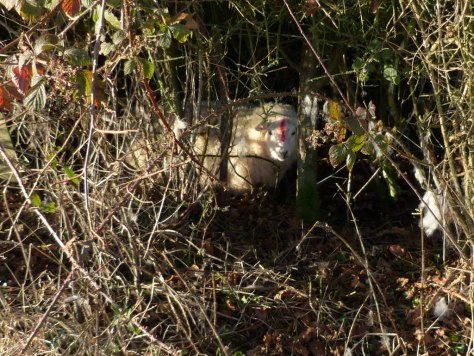 She was a very nice Sheep and I am glad that we didn’t just leave her there for the Wolves but by the time we had freed her most of the frost was gone.
She was a very nice Sheep and I am glad that we didn’t just leave her there for the Wolves but by the time we had freed her most of the frost was gone.
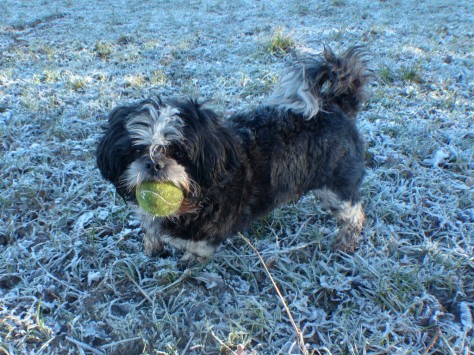 So I will introduce you to my Robins instead.
So I will introduce you to my Robins instead.
These two birds are not very exciting at the moment but they might be famous in a few months so this is just a sneak preview.
They live just outside of my back door and I am trying to get them eating out of my hand. For a few weeks now I have been putting a few worms down each time I open my door and sitting quietly to watch them. It hasn’t been going very well, they wait for me to go inside before they swoop down and take them but in the last couple of days they have been taking the food while I am still there.
Training my Robins might take a little time but this is the start.
European Robins have a close association with people, they follow gardeners about because they turn the earth and expose worms and other tasty treats. They used to follow Wild Boar for exactly the same reason. They are very intelligent birds and to them a gardener is just a more upright Wild Boar. That’s what I want to be.
It would be lovely to feel their weight, light on my hand.
Flowers now and this one isn’t flowering yet but it is one of the early ones to look forward to.
Caltha palustris, The Marsh Marigold
Marsh Marigolds are one of our most ancient flowers, believed to have been growing here since before the last Ice age and to have survived that ice age and flourished in the melting waters. The last Ice age ran from about 110,000 years ago until 12,000 years ago, it was a long winter and this is an old flower.
It is found all over the UK and is native to much of the Northern Hemisphere including North America and Canada. It does well in cold climates.
In the UK it flowers in February and can last until April.
 It is a waterside plant, growing in or on the edge of running water, it also grows in the ponds here on the farm and in wet woodland.
It is a waterside plant, growing in or on the edge of running water, it also grows in the ponds here on the farm and in wet woodland.
This next picture shows the typical habitat, showing young plants growing alongside and through a woodland stream. This picture was taken on the 27th of February 2014.
 These flowers were photographed on the same day and in the same location as the previous picture.
These flowers were photographed on the same day and in the same location as the previous picture.
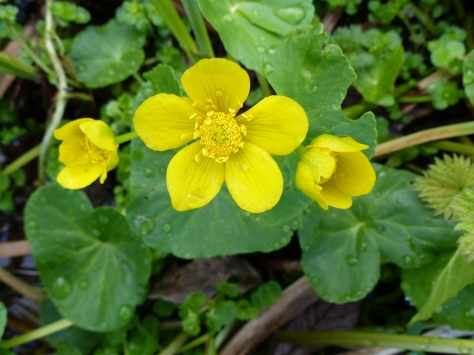 Marsh Marigold is a member of the Buttercup family and I have heard it said that it is easily confused with other buttercups and even Lesser Celandine. They are all related and yellow but the Marsh Marigold flower is twice the size of any of the others, about two inches across it has quite dense and luxuriant foliage and it grows in water. There is really nothing that you can confuse it with.
Marsh Marigold is a member of the Buttercup family and I have heard it said that it is easily confused with other buttercups and even Lesser Celandine. They are all related and yellow but the Marsh Marigold flower is twice the size of any of the others, about two inches across it has quite dense and luxuriant foliage and it grows in water. There is really nothing that you can confuse it with.
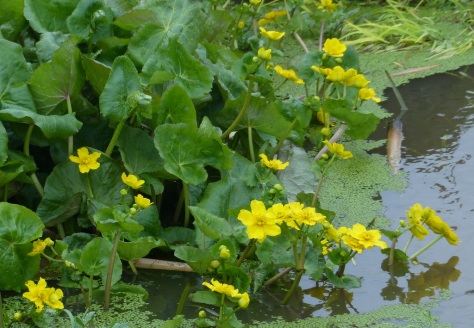 This primitive flower doesn’t have petals, it has bright yellow sepals.
This primitive flower doesn’t have petals, it has bright yellow sepals.
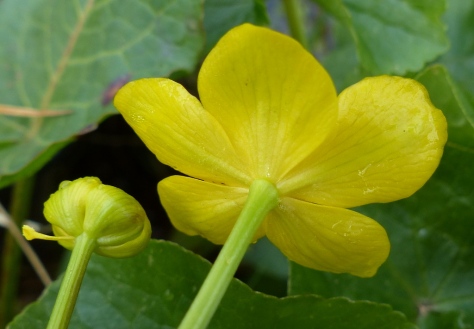 At the bud stage the outside of these sepals can be quite green.
At the bud stage the outside of these sepals can be quite green.
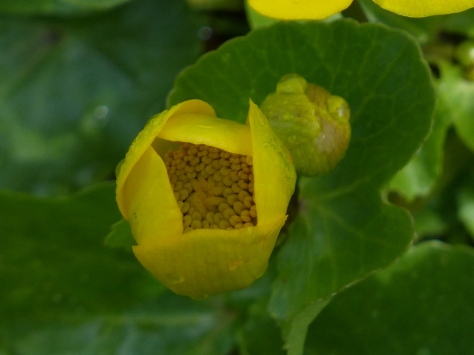 Five sepals is the norm but they can have as many as nine, this next flower has six.
Five sepals is the norm but they can have as many as nine, this next flower has six.
 Inside the sepals are multiple stamens and styles.
Inside the sepals are multiple stamens and styles.
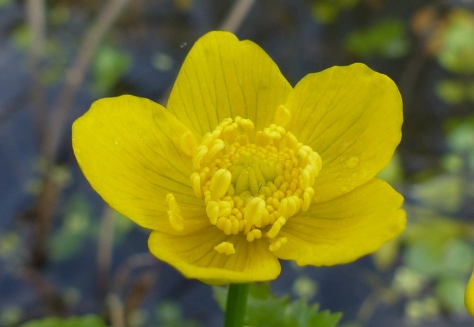 The leaves are very variable, round to heart shaped, they can be six inches across and the leaf edge varies from smooth to sharply toothed. Generally the foliage is luxuriant.
The leaves are very variable, round to heart shaped, they can be six inches across and the leaf edge varies from smooth to sharply toothed. Generally the foliage is luxuriant.
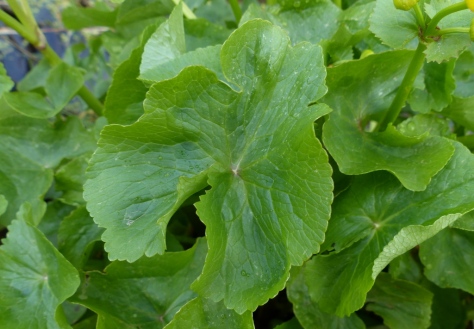 Note the small sharply toothed leaves in this next photograph.
Note the small sharply toothed leaves in this next photograph.
Kingdom: Plantae
Order: Ranunculales
Family: Ranunculaceae
Genus: Caltha
Species: Caltha palustris
I will leave you with Frosty celebrating the day that she saved a Sheep.

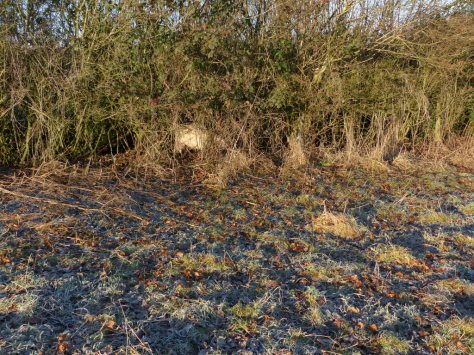
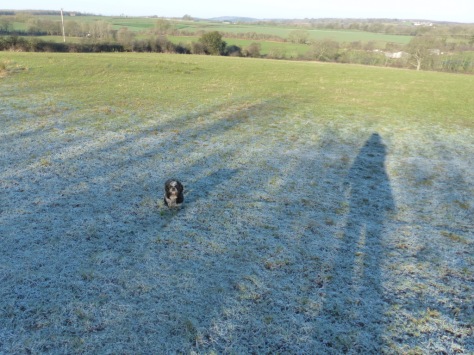

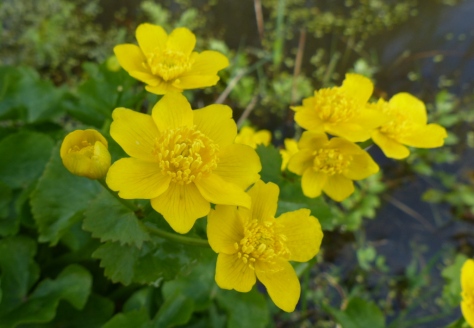
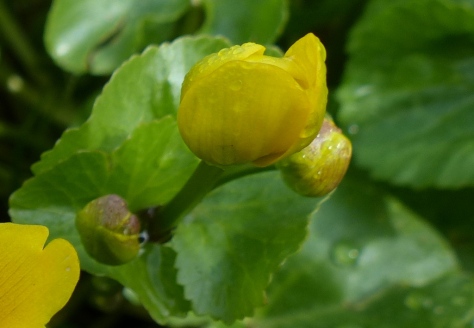
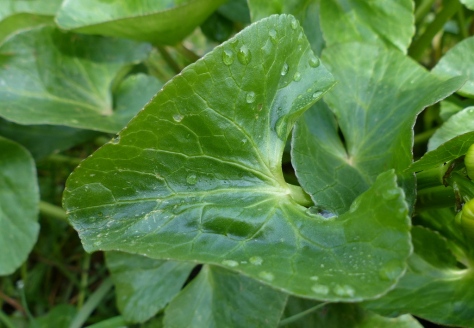
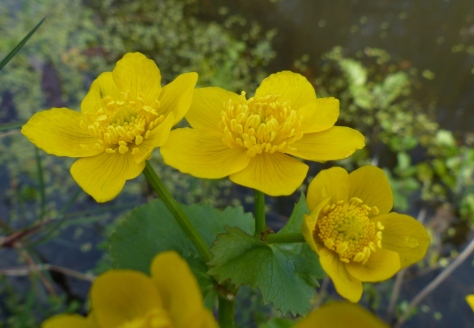
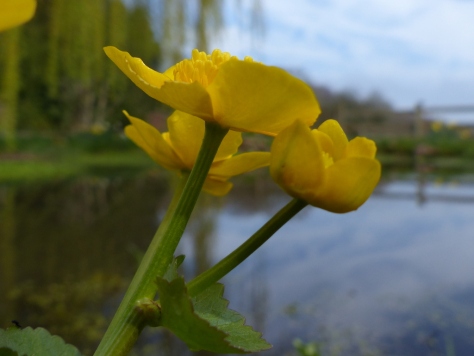
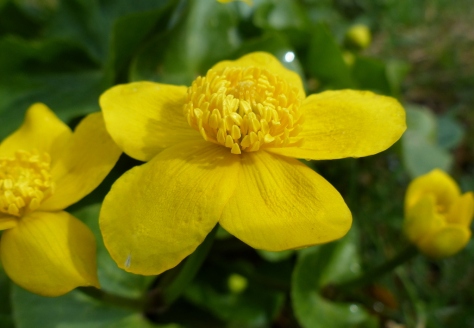
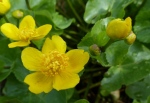
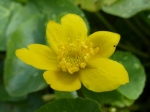
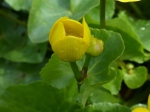




The Marsh Marigolds are beautiful little flowers. Good luck with the robins!
LikeLike
Thank you Sarasin 🙂
LikeLiked by 1 person
From what I can tell you’ve no chance of your Robins following a wild bore.
LikeLike
Thank you Stephen 😀
LikeLike
Good work you two!
LikeLike
Thank you Emily 🙂
LikeLike
What a clever little shepherd dog she is!
LikeLike
Thank you my friend 🙂 You haven’t seen the best of it yet. I normally keep Fizz on a lead around sheep because she chases them. The farmer, who owns both Fizz and the sheep, has asked me to let her go and let her get used to them. He says the sheep are young and she won’t hurt them, a run is good for them. They only run so far and then they stop and turn around, there are thirty six of them and all much bigger than Fizz. The sight of Fizz being chased around the field by thirty six sheep is priceless. I will try and get it on video 🙂
LikeLiked by 1 person
I think she might stop when the leader sheep turns around and eyeballs her. I wish you all the best for 2015
LikeLiked by 1 person
Okay a little bit of trick photography involved but yesterday she split them and got in the middle and with half of them running behind her it looked just like they were chasing her around the field.
Sheep are turning out to be much more interesting than I ever imagined.
We feed them, there are only a few and the farmer tells me they are easier to handle if they are used to people. Fizz tries to snatch bread from them and they are very stroppy, putting their heads down and making little runs at her. They will all challenge her.
When I put cameras out in the field to film Badgers I got a lot of sheep and I was surprised at how much they fight amongst themselves with a lot of head butting and pushing around. I suppose that they were fighting for the Badger bait as I haven’t seen them act like this when I am present.
The most interesting thing has been that they can see and are interested in my camera. A fox will look at it but that is really the only other reaction that I get from animals. The sheep investigate it. I have got lots of videos of sheep licking the camera or otherwise mouthing and nudging it. No other animal even notices the small black box tied to a tree.
In fact I moved my camera because they wouldn’t leave it alone.
Interesting animals.
LikeLike
Those marsh marigolds look very nice.
LikeLike
Thank you Hien 🙂
LikeLike
The stuck sheep thing… is this a common occurrence? Poor thing. Glad you were able to assist with the rescue.
LikeLiked by 1 person
Thank you Maggie 🙂 More common than I realised. These young sheep were only released into the main fields on Boxing Day and this is the second one found stuck in the hedge. Fizz and I have been issued with our own pair of cutters and given instructions on the routes we must walk. It seems like for a while at least we are going to have to keep an eye on the sheep.
LikeLike
Just to add to that we have just been out to get them in off the fields so that the old boy could have a look at them and we found another animal stuck in the hedge. This is now an epidemic. Apparently their wool is too long but he can’t shear them in this weather and the hedgerow is too wild. It needs to be cut. They are all in the orchard for now.
LikeLike
Looks like you can add “shepherd” to your resume! Can Fizz handle the new role as sheep dog, I wonder? 😉
LikeLike
I probably shouldn’t mention this but Fizz didn’t come on the round up. I was given the role of sheep dog (anticipate their movement and stand in their way) and it all went very well but did I get a biscuit?
LikeLike
Well! I’d take the biscuit business up with the union rep! The nerve! 😉
LikeLike
Sheep are a bit silly aren’t they? I’m glad Frosty and her side-kick came to the rescue. I am pleased that our Marsh Marigolds are spreading round the garden – I found two new plants last spring. They are so bright and beautiful.
LikeLike
Thanks Clare 🙂 Do your Marsh Marigolds grow on dry land? I have only ever found them in the wild growing in very wet conditions.
LikeLiked by 1 person
Surprisingly, the new plants are at the top of a ditch in a place that is never under water. We have had a very wet year, extremely so for East Anglia, and this is the first time I have noticed new plants. The original two plants are 1. roots under water all the time and 2. roots under water some of the time. I will keep an eye on the new plants and if we have a dryer year I might consider transplanting them to a damper place. I don’t usually interfere with wild plants – they know where they want to be – but I don’t want to lose these.
LikeLike
Very exciting post today. Rescuing trapped sheep and training robins all in the course of a day. I love marsh marigolds, they are so bright and cheerful – they simply shout spring. Your descriptive details and photos are excellent – your guide is going to one of the best there is. You and Fizz will be even more famous than you already are!
LikeLike
Thank you Eliza 🙂 The sky is just getting light now and I am giving the Robins their breakfast. It was a clear sky for most of the night and there was a heavy frost. They have so little fat on their bodies, it makes me wonder how they survived. They are quite chippy this morning 🙂
LikeLike
I’d be chippy, too, if I was offered a tasty, free breakfast. Here is a fascinating look at bird adaptation to cold that may interest you: http://beyondpenguins.ehe.osu.edu/issue/arctic-and-anarctic-birds/how-do-birds-stay-warm
LikeLike
I’ve never seen marsh marigolds flowering in February – amazing. When we lived in North Wales we had a robin that would come onto our hands (and plates, when we had lunch outside!) so I am sure you will succeed! Nice pics of Fizz too. When she’s squirming it’s hard to know where the frost ends and her fur begins!
LikeLike
Thanks Jo 🙂 I am confident that the Robins will get me trained eventually. As to the Marsh Marigolds, they are in the ponds behind the farm and I shall be keeping a much closer eye on them this spring to see when the first one flowers.
LikeLiked by 1 person
What you need is meal worms from the fishing shop, Colin. The bird photographers here take them everywhere. The birds can’t get enough. I think it is cheating but the ‘togs do it anyway. What did Fizz get as a reward for rescuing a sheep? Did it say “thank you”? Sheep can be quite ambitious but as someone famously said they are not good aeronautically. If they get up in a tree they do not so much fly as plummet. Baaaaaa.
LikeLike
Thanks Andrew 🙂 I have looked but I can’t get live meal worms locally so I am plodding on with the dried sort. I am making headway. The birds are coming down now when I step outside, even if there were worms there before I opened the door, they seem to be making the association between me and food. More disconcerting, yesterday and today I keep noticing one Robin sitting outside of my window and looking in at me. I am sure that is just coincidence….but, you know, I only really came up with this idea that I could tame them because every time I opened my door there would be a Robin cheeping loudly at me as if it wanted something and I thought well, that’s cute.
It does make me wonder who is training who?
LikeLiked by 1 person
Are you sure it is a Robin at the window, Colin. It could be a spy drone camouflaged to lull you and Fizz into a false sense of security. You are being watched.
LikeLiked by 1 person
Many thanks for “The Secret Garden II”. 🙂 I’ve commented your latest posts in my blog:
Would You Like “The Secret Garden II”? Read Colin Blog! 🙂
https://ppthephoenix.wordpress.com/2014/12/31/would-you-like-the-secret-garden-ii-read-colin-blog/
Hapy New Year Sir!
P.S. For the second time, small faux pas, but the first wishes were written in other, earlier post of mine.
LikeLike
Thank you so much Przemyslaw 🙂 You are as lyrical as ever.
LikeLike
Oh goodness, the sheep! How marvelous you rescued her. Ahhh, Happy New Year to you, Fizz and friends.
LikeLike
Oh please do!
LikeLike
The “Oh, please do” comment was supposed to be up where you mentioned posting a video of Fizz being chased by a herd of sheep. Evidently the fine points of posting comments eludes me this morning.
LikeLike
Thank you Barbara 🙂 Unfortunately the Sheep are confined to the orchard now for their own safety, until we can get this bramble epidemic under control.
LikeLike
I love the sheep! It’s super-cute 😀
LikeLike
Thank you Becky 🙂
LikeLike
Robbins follow the riding lawn mower when my husband mows the grass. I think it’s so funny.
LikeLike
Thank you Sandi 🙂 It is great the way that they notice us and take advantage.
LikeLiked by 1 person
Glad you saved the sheep. I have a pair of Robins who come to the feeder on my patio. The male is gallant. Sometimes he offers the lady a sunflower seed.
LikeLike
Thank you Ibeth 🙂
LikeLike
Well that brings a whole new meaning to counting sheep! Those wooly new adventures will keep you spinning more yarns. Regarding the robins, they do stalk me in my garden. Maybe if I sprinkle some worms on my blog I could get the robins to follow me there? Hope you have the touch to bring them around, look forward to the tale. The buttercups bring back memories of short canoe excursions with my husband, where I always insisted on cutting a bud or two to bring back from the patch much to his dismay (he was afraid I would tip the canoe, but it never happened 🙂 ). Fizz. That’s all there is. She is a one word wonder :)
LikeLike
Thank you Stephanie 🙂 Counting sheep is not as easy as people think. We have thirty six and Fizz and I are supposed to count them whenever we see them. If we can only count thirty then that is probably okay, a few have got split up but if we count thirty five then alarm bells ring. One missing is trouble. It is really hard to tell the difference between thirty five and thirty six sheep. Especially when we keep falling asleep 🙂
LikeLiked by 1 person
[chuckles]
LikeLike
Thank goodness you were around to find the sheep and free her. Love the Robin video clip too. I think you’ll be able to entice it on to your hand in no time at all.
Look forward to seeing some more Marsh Marigolds too.
LikeLike
Thank you Vicki 🙂
LikeLike
Your sheep incident reminded me of all the times my plans on the farms I lived on were changed due to injured or birthing sheep. Most times the intervention involved having to catch a fly blown (maggoty) sheep. The warm, moist wool around the rear of the sheep is a good place for flies to lay eggs. I won’t go into the rest as you may be having breakfast. 🙂 I wonder how much you were bleeding after helping the sheep out of the brambles. They look nasty. Fancy Fizz forgetting the SD card…tut tut. 🙂 Lovely robin video. Maybe we’ll see you and the robins on a You-tube hit?! They are beautiful little birds. I, too, would love to feel them on my hand. My young son did something similar with our Willie Wagtails (fly catchers) years ago. They would fly down to his hand to take grubs and other insects. He was a bit of a “bird whisperer”. 🙂
LikeLike
Thanks Jane 🙂 We do have some maggot problems here but I leave that sort of stuff to the professionals. The biggest problem that we have seems to be the wet ground, they get problems with their feet. Locally there is an ancient law that gives people living within the forest boundaries the right to let their sheep wander freely. It is common to meet sheep as we wander around the forest or to find them in villages and strolling down busy roads. I don’t know how this works, how they care for them or even how they get them back.
LikeLike